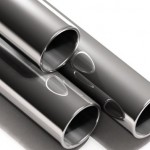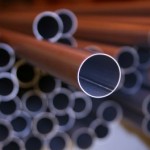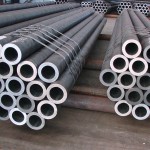High Carbon Steel

High Carbon Steel contains more than 0.7% carbon upto 1.5%. These steels have high hardness and low toughness. The combination of these properties makes it ideal for bearing applications where wear resistance is important and compressive loading minimize brittle fracture that might develop on tensile loading. Strength to hardness increase with increase in carbon contents. As the carbon is increased hardness increases and strength starts decreasing. Ductility and machinability of steel decreases with increase in carbon content from mild steel onwards.
High Carbon Steel is one of the most important construction metals in the world. While this is common knowledge, many people do not understand the difference between high carbon steel and other types of steel.
Steel with 1.25% carbon is very brittle unless there are some other balancing elements. The low-carbon steels machine easily and can be forged readily. Above 0.90% carbon are difficult to forge and machine. All steels contains manganese less than 0.3% left after deoxidizing and desulphurizing with ferromanganese
High Carbon steels are classified as follows
1) Steels containing 0.7 to 0.8% carbon. The tensile strength is about 1400 N/mm2 and a hardness of 45–500 BHN. These steels are used for making:
- Cold chisels
- Wrenches
- Jaws for vices
- Pneumatic drill bits
- Wheels for railways service
- Wire for structural work
- Shear blades
- Hacksaws
- Automatic clutch discs
2) Steel containing 0.8 to 0.9% carbon. The tensile strength is about 600 N/mm2 and a hardness of 500 to 600 BHN. Such steels are used for making:
- Rock drills
- Railways rails
- Circular saws
- Machine chisels
- Punches and dies
- Clutch discs
- Leaf Springs
- Music Wires etc
3) Steel containing 0.90 to 1.00% carbon (high carbon tool steels). The tensile strength is about 580 N/mm2 and a hardness of 500-600 BHN. Such steels are used for making:
- Punches and dies
- Springs (Leaf and coil)
- Seed discs
- Keys
- Pins
- Shear Blades
4) Steels containing 1.0 to 1.1% carbon. They are used for making:
- Railway Springs
- Machine tools
- Mandrels
- Taps
5) Steel containing 1.1 to 1.2% carbon. They are used for making:
- Taps
- Twist drills
- Thread metal dies
- Knives, etc
6) Steels containing 1.2 to 1.3% carbon. They are used for making:
- Files
- Metal Cutting tools etc
- Reamers
7) Steel containing 1.3 to 1.5 % carbon. They are used for making:
- Wire drawing dies
- Metal cutting saws
- Paper knives
- Tools for turning chilled iron etc.










